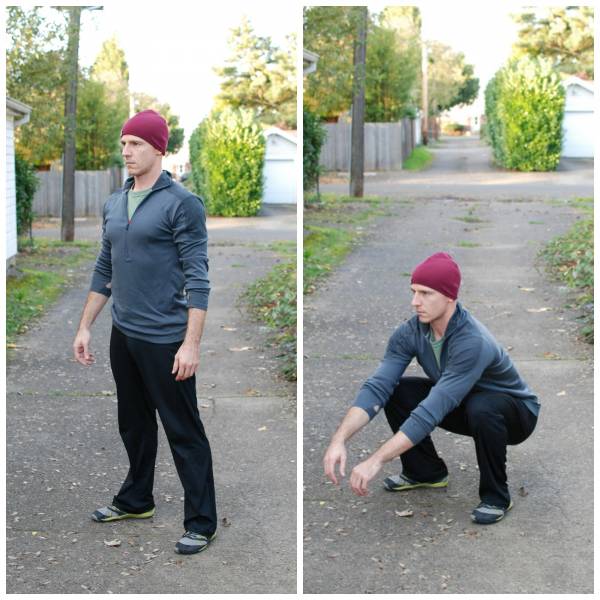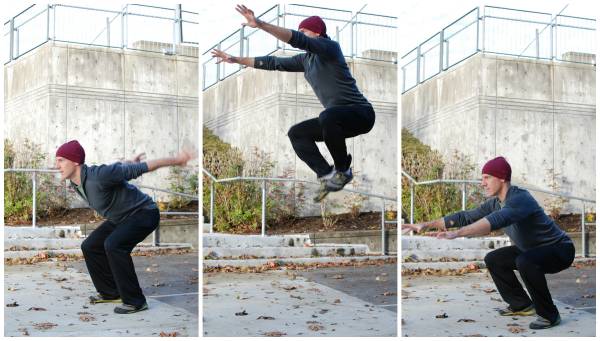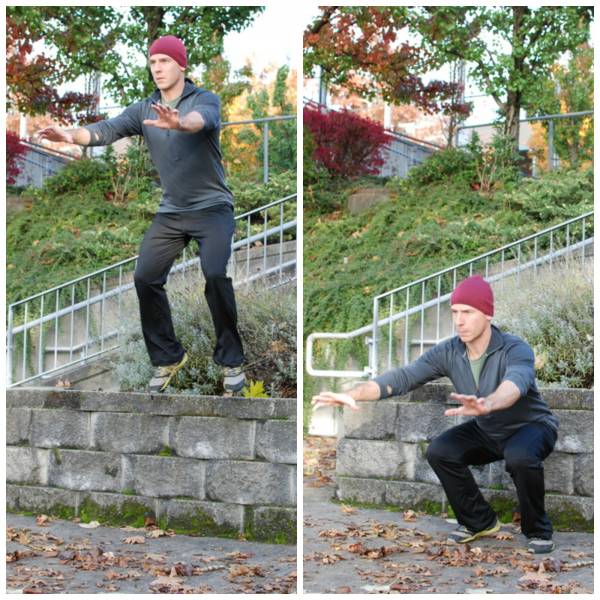In a prior article, we talked about the climb-up as a useful tool for getting yourself on the top of a wall. But what happens when you need to get back down?
Descending from an elevated surface can be a unique challenge. Land wrong and you risk spraining an ankle or injuring some other joint. Forget trying to get down from something – sometimes even a faulty landing from a simple jump can lead to a blown-out knee.
As the saying goes: What goes up must come down! So, in the name of an injury-free training career, we are going to talk about key concepts with landings as they pertain to parkour.
In this article we aren’t going to delve into break falls and rolling techniques for when landings go bad. For the sake of brevity, we are going to limit the discussion to landings in which you drop directly to your feet.
Flexibility First
To begin, let’s think about basic flexibility as a key requirement for safe landings. You would never drop straight-legged from a jump of any kind, would you? Your heels would get bruised, and it would be a pointless amount of impact to take through your knees and hips.
“A tenet of parkour conditioning is that your landings should always be on the balls of your feet.”
Instead, what do you do? You allow your legs to bend, sucking up the compression as soon as your feet make contact with the ground.
Imagine what happens if you are restricted in any range of motion in your legs. Gravity is a law of nature and your mass is returning to the Earth regardless of your tight joints. Something has to give, and if the force is great enough, you risk snapping some connective tissue.
Without writing a treatise on flexibility, let’s keep it simple and say at the most basic level, the ability to obtain a full squat is essential for not getting hurt. You’re shooting for full ankle, knee, and hip flexion, allowing your heels to stay on the ground while your body is curled up in a tight crouch. Remember the squat you did when you had go number two outdoors while backpacking? That’s what we’re looking for – nice and deep.
Strong Legs for Safety
Next, what is your leg strength like? Can you counter the force that is about to grind through your joints?
“[S]mooth and soft forefoot landings simply look way more ninja than crashing to ground on flat feet!”
When you land and let your legs bend, you aren’t being passive. You are actively countering the force that is pulling you into that deep squat. Your calves, quads, and glutes must fire eccentrically to slow the rate of flexion. If they weren’t working in this manner, you would crumple to the ground, unable to change your direction of travel.
Let’s go over a few of the exercises that you can do to improve your leg strength for safe landings:
Air Weight Squats
Start in a standing position, and then bend your hips and knees to lower your bottom to the ground. Try to keep your weight balanced between your toes and heels, and avoid letting your knees cave inward.

Aim to move through your full range of motion, from full and upright extension to a completely crouched posture. If you feel any stiffness at your knees or ankles, make a note of it and add specific flexibility work later. You should be able to do at least ten repetitions at time without rest.
Tuck Jumps
Think of this like a squat jump, except you should pull your knees up to your chest as high as you can at the top of the jump. Land back on the ground as softly as you can, absorbing the impact through flexed legs.

Shoot for a goal of five reps at a time, jumping as high as you can and really compressing yourself at the top. Aim to be as quiet as possible during the entire movement.
Drop Jumps
Stand on a low park bench, weight bench, or plyo box. Step off the top and allow yourself to drop to the ground. Land softly and absorb the impact by allowing your legs to flex beneath you. Again, be cautious that your knees don’t cave inward.

Once you feel comfortable with stepping off, change to hopping off the top with both feet. Still land as softly as you can. And there’s no point in punishing your knees with too many drops, so limit your repetitions to a handful at a time. Likewise, keep them low to the ground – don’t be in a rush to try these from progressively higher surfaces.
A Final Word About Technique
A tenet of parkour conditioning is that your landings should always be on the balls of your feet. The rationale has a variety of explanations, including better shock absorption across the ankle and a smaller surface area to help with more precise landings.
From a biomechanical perspective, another critical reason for landing on the balls of your feet is that it drives your knees forward into a flexed position. Landing with extended knees can be catastrophic, leading to injuries such as an ACL tear. So, for the health of your knees always strive to land lightly on the balls of your feet.
Plus, smooth and soft forefoot landings simply look way more ninja than crashing to ground on flat feet!
For more parkour skills, strength, and drills:
- Parkour Plyometrics: 3 Drills to Develop Explosive Leg Strength
- 7 Simple Ways to Avoid Injury in Parkour
- Mastering the Parkour Wall Climb
- What’s new on Breaking Muscle Today






